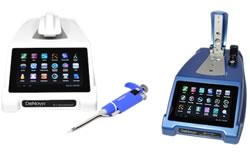Recent News & Events
Microvolume Spectrophotometers Allow Researchers To Do More With Less!
21
 Microvolume Spectrophotometers not only allow researchers to do more with less, they allow for faster and more accurate results as well. DNA, RNA and protein quantification has been truly revolutionized by Microvolume Spectrophotometers when compared to the previous spectrophotometer technology available that requires the use of cuvettes or capillary tubes to house samples for testing.
Microvolume Spectrophotometers not only allow researchers to do more with less, they allow for faster and more accurate results as well. DNA, RNA and protein quantification has been truly revolutionized by Microvolume Spectrophotometers when compared to the previous spectrophotometer technology available that requires the use of cuvettes or capillary tubes to house samples for testing.
NanoDrop Technologies, Inc. (now part of Thermo Fisher Scientific) was founded in 2000 by Charles W. Robertson, PhD, Patricia Robertson, Fred Kielhorn and Lynne Kielhorn to provide researchers with a means of spectroscopic analysis that allowed them to determine protein concentrations of smaller samples than had ever been possible before. These pioneers not only developed the first Microvolume Stectrophotometers, they also provided inspiration and means for future generations of Spectrophotometers to be developed using Microvolume technology that require smaller and smaller samples, which continue to be developed to this day. In fact, the founders of NanoDrop Technologies, Inc., Charles W. Robertson PhD and Fred Kielhorn formed DeNovix in 2012 with the goal of developing innovative products of outstanding value for the life science community and their first line of products was the DS-11 Spectrophotometer. Working with others that had worked on the NanoDrop line, like Joel Hansen, PhD, Deborah Conklin and David Ash, they have made incredible improvements in not only the technology but in the price point as well.
Denovix achieved their goals with the development of the DS-11 FX model which integrates a Fluorometer with the base Spectrophotmeter to combine UV-Vis Absorbance and Fluorescence methods in a compact, maintenance and calibration free instrument. The biggest differentiator between DeNovix and all other UV-Vis spectrophotometer manufacturers is their integrated Fluorometer with improved accuracy and lower detection levels.
Methods for determining protein concentration that use progressively smaller amounts of material are continually being developed. At the same time, the results achieved boast greater accuracy as well. These innovative new approaches minimize the amount of sample used for spectroscopic analysis while providing more opportunities for greater quality control. Traditional spectrophotometric and fluorometric methods for determination of protein concentrations require the transfer of samples into containment devices such as cuvettes or capillaries. Finger prints and environmental factors can contaminate these containment devices during the transfer process which increases the number of potential failure points that can render results useless and waste not only time but valuable and in some cases very limited sample resources. Besides the time lost redoing the work, more of the sample may need to be created, and worst case scenario, there may not be any more available. Microvolume Technology solves both of these problems by drastically reducing the sample size required and eliminating the need for intermediate transfers. Instead, micro samples are entered directly into the instrument where the natural properties of surface tension are utilized to capture and contain micro samples during measurement and in doing so offer a level of quality control that was unheard of with the older technology.
